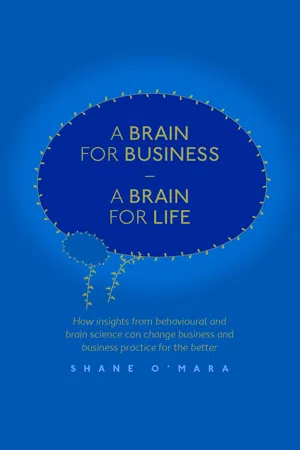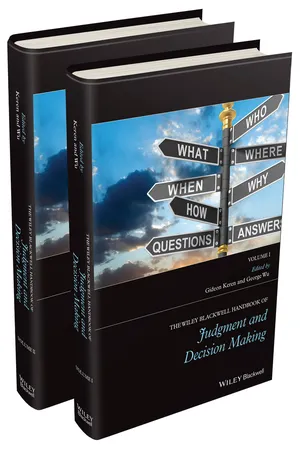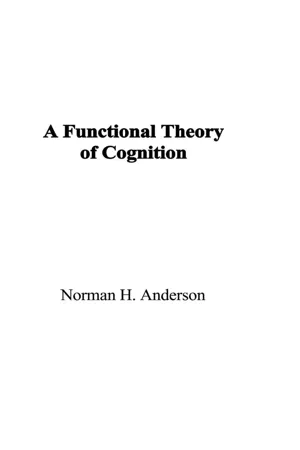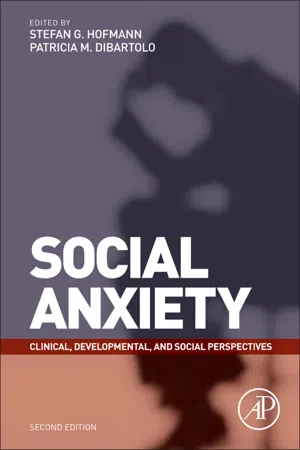Cognitive Bias
Cognitive bias refers to the systematic patterns of deviation from rationality in judgment and decision-making. These biases are often influenced by factors such as past experiences, emotions, and social influences, leading individuals to make subjective and sometimes irrational judgments. Understanding cognitive biases is important in psychology as they can impact various aspects of human behavior and decision-making processes.
7 Key excerpts on "Cognitive Bias"
- Amy E. Wenzel(Author)
- 2017(Publication Date)
- SAGE Publications, Inc(Publisher)
...Jennie M. Kuckertz Jennie M. Kuckertz Kuckertz, Jennie M. Nader Amir Nader Amir Amir, Nader Cognitive Bias Cognitive Bias 747 749 Cognitive Bias Cognitive Bias refers to a pattern of selectively processing emotional information in one’s environment. Cognitive Biases have been observed across many forms of psychopathology including obsessive-compulsive disorder, posttraumatic stress disorder, depression, substance abuse, eating disorders, and anger. However, the majority of Cognitive Bias research has focused on anxiety and depressive disorders. In addition to being correlates of psychopathology, Cognitive Biases may also be involved in the maintenance and etiology of psychopathology, with some research suggesting that experimental manipulation of these biases leads to reduction in symptoms. Within cognitive psychology, Cognitive Biases are most commonly discussed in three domains: (1) attention, (2) interpretation, and (3) memory. This entry summarizes each of these domains as well as their relevance to mental health disorders. Attentional Bias Attentional bias refers to the tendency to focus one’s attention on emotionally salient information when this information competes for processing resources with nonemotional information. Attentional biases may be present for information that is either presented verbally or visually. Visual attentional bias may take one of two forms: (1) enhanced engagement with specific stimuli or (2) difficulty disengaging from specific stimuli...
- eBook - ePub
A Brain for Business – A Brain for Life
How insights from behavioural and brain science can change business and business practice for the better
- Shane O'Mara(Author)
- 2017(Publication Date)
- Palgrave Macmillan(Publisher)
...Biases in decision-making may serve to reinforce affiliation or strength of the bonds within a tightly defined group, for example. Biases may also serve to punish behaviour that is seen to be transgressive—taking too much reward for too little effort (free-loading), for instance. In this case, there may even be a willingness to engage in costly punishment— to punish a member of one’s own group, or to punish an opposing group, even if there is an economic cost to oneself and to one’s group (Heinrich and colleagues 2006). The question posed by the group is simple: ‘what sort of a hit are we willing to take in order to teach the other lot a lesson?’ Both history and experiments show that humans are willing to take punishments in order to teach the other side a lesson—costly punishments that would not be prescribed by a purely rational calculus. The other side in the dispute may assume that there will be no costly punishment, as in believing that ‘they won’t impose trade sanctions on us. After all, they sell us a lot of cheese (or cars, or wine, or shoes—or whatever)’. But they can, and they will. A refusal to recognise in a negotiation that one side will act contrary to their own narrowly defined economic self-interest to ensure a broader political, legal and social lesson is learned is a very common mistake. Cognitive Biases are a pervasive and universal aspect of human thinking. In essence, they are systematic biases in gathering information and in thinking that lead to a deviation from rationality calculations or even simply what is demonstrably ‘good and fair judgement’. The case study in the Chapter 1 of this book provides many examples of many Cognitive Biases, and we will discuss a few them below. There are huge numbers of biases—the Wikipedia entry for ‘ Cognitive Bias ’ lists more than 175 of them...
- eBook - ePub
Reasoning, Rationality and Dual Processes
Selected works of Jonathan St B.T. Evans
- Jonathan Evans(Author)
- 2013(Publication Date)
- Psychology Press(Publisher)
...We store vast amounts of information from which – in contrast with existing computer systems – we can access with the greatest of ease just those parts relevant to our current situation. Our perceptual abilities are perhaps even more astounding, far exceeding those of the most skilfully programmed supercomputer. But what happens when the owner of this remarkable brain is taken into the psychological laboratory and asked to perform apparently straightforward tasks requiring reasoning or judgement? The answer is that a whole range of systematic errors and biases is produced. People ignore relevant information or attend to irrelevant features of the tasks and their performance is highly dependent upon the precise content and context in which a logical problem is presented (see Evans, 1989, 1992). So, human beings are highly intelligent on the one hand and chronically biased in their reasoning and judgement on the other. This paradox has gripped and perplexed a number of authors in the recent psychological literature. Bias researchers such as myself have been forced, however reluctantly, to consider what implications our research findings and their interpretation have for the notion of human rationality. In particular, the research fields have come under attack by those who appear to regard rationality as axiomatic. Criticisms of bias research and researchers include the following claims: 1 Authors selectively cite evidence of bias and ignore studies reporting good reasoning (Christensen-Szalanski and Beach, 1984). 2 Errors are judged relative to an arbitrary normative system such as standard logic or probability theory, whereas subjects may use some alternative system (Cohen, 1981, 1982). 3 Rationality is bounded by cognitive-processing constraints...
- Gideon Keren, George Wu, Gideon Keren, George Wu(Authors)
- 2015(Publication Date)
- Wiley-Blackwell(Publisher)
...At least part of the problem is informational. Scientific and statistical training is practically nonexistent in the law-school curriculum, the forensic sciences are insufficiently scientific in their approach to conclusions (Mnookin et al., 2011; Saks & Koehler, 2005), and the majority of jurors are not equipped to sort through the technical issues on their own. Errors such as those described here not only occur with great regularity but they are also often defended as proper. Calls for greater attention to identifying rates of error are resisted within the forensic science community (Budowle et al., 2009). These realities leave us pessimistic about the likelihood of major reform in the near term. Cognitive Biases Following Tversky and Kahneman’s influential work detailing the representativeness, availability, and anchoring heuristics (e.g., Kahneman, 2011; Tversky & Kahneman, 1974), legal scholars quickly recognized that Cognitive Biases affect nearly every aspect of the law, from contract negotiations to plea bargaining and settlement strategies to judicial admissibility decisions to jury verdicts to sentencing. The so-called behavioral law and economics movement has grown in recent decades to the point where there are now bodies of literature in the legal domain that expressly address the role that various cognitive limitations play on various legal judgments and decisions. Below, we discuss several well-known Cognitive Biases and how they affect various legal actors. Confirmation bias Confirmation bias is ubiquitous in real life and nearly every area of the law. Confirmation bias is a form of Cognitive Bias in which people search for, interpret, and recall information in a manner that favors their preexisting beliefs and hypotheses (Klayman & Ha, 1987; Nickerson, 1998). Although confirmatory testing and updating is often rational and appropriate (Klayman & Ha, 1987; Koehler, 1993c, pp...
- eBook - ePub
Why We Do What We Do
Understanding Our Brain to Get the Best Out of Ourselves and Others
- Helena Boschi(Author)
- 2020(Publication Date)
- Wiley(Publisher)
...chapter seven Our Brain and Biases ‘There is no neutrality. There is only greater or lesser awareness of one's bias.’ PHYLLIS ROSE Literary critic, essayist, biographer and educator (1942–) ABOUT THIS CHAPTER Being biased is a human phenomenon. We are all biased and we use our biases every day, often unconsciously, to help us make decisions. Biases are the beliefs, attitudes and preferences that we form about ourselves and other people. We pick up these biases through our culture, background and education and they are pervasive influences over how we see the world and make decisions. Our brain has to predict rapidly what is safe or harmful in our environment. To help our brain do this, our biases quickly shortcut new information. The problem is that they intervene so quickly that we may make a bad choice or overlook a crucial detail. This chapter explains how biases work in our brain and shows how our biases may distort our thinking or prevent us from forming an accurate view of the world. Part 1: The science explained A psychological immune system in the brain Our biases are human adaptive responses to our environment and provide an immediate frame of reference for fast interpretation and action. In a sense, our biases are our brain's psychological immune system and prevent us from decision paralysis. 1 If we were unable to respond quickly to our surroundings we would not have been able to survive as a species. FIGURE 7.1 : We are all biased Why are our biases so powerful? Our biases (Figure 7.1) play a more powerful role in our decision-making than many of us realise, particularly when we have limited information or when we are in a heightened emotional state...
- eBook - ePub
- Norman H. Anderson(Author)
- 2014(Publication Date)
- Psychology Press(Publisher)
...The biosocial heuristic also suggests that so-called biases often have deep-seated origins and will not be easy to change, a suggestion that accords with the long history of difficulties in changing behavior. Understanding behavior is generally prerequisite to improving it, but understanding requires a cognitive framework (see also Levin, Louviere, Schepanski, & Norman, 1983; Lopes, 1987a,b). 16 A third locus of cooperation lies in applying cognitive theory to realistic problems, especially field problems of business and government. Cognitive approaches tend to simplify experimental tasks, a tendency that often feeds on itself, with increasing loss of generality and relevance to everyday life. Normative approaches stand out for their concern with real problems of society. They can have a vitalizing influence on cognitive approaches. UNIFIED THEORY Cognitive algebra is a cornerstone for unified theory of judgment-decision. Unity appears in the applicability of the same concepts and methods across the diverse applications surveyed in this chapter. Generality also begins to appear in these applications, which cover many classical problems of this field. Unity and generality appear further in applications to other domains as different as memory, attitudes, and ethics, which are considered in other chapters. Judgment-decision may be considered a unifying framework for psychology. The kinds of problems considered in this chapter underlie thought and action in every domain. No domain theory can go far without resolving these judgment-decision problems in its particular context. Despite the many differences between such domains as social-personality, psychophysics, and language processing, for example, similar processes of judgment-decision are common to all...
- eBook - ePub
Social Anxiety
Clinical, Developmental, and Social Perspectives
- Patricia M. DiBartolo, Stefan G. Hofmann(Authors)
- 2010(Publication Date)
- Academic Press(Publisher)
...Chapter 14 Cognitive Biases in Social Anxiety Disorder Nader Amir and Jessica Bomyea Joint Doctoral Program, San Diego State University/University of California, San Diego, CA, USA Introduction Psychopathologists have been greatly influenced by information processing models of emotional disorders, suggesting that preferential processing of threat-relevant information (i.e., information processing biases) underlies these disorders (Beck, Emery, & Greenberg, 1985 ; Williams, Watts, MacLeod, & Mathews, 1988, 1997). Information processing biases are thought to influence attending to, remembering, and interpreting threat-relevant information leading to the maintenance of anxiety. Although it is likely that such biases may play a role in the development of anxiety, most studies of information processing bias in anxious individuals have been descriptive and correlational in nature. However, since the first edition of this book, researchers in this area have begun utilizing experimental approaches to modifying information processing biases. Based on a number of these studies, it appears that observed information processing biases may be causally implicated in anxiety. A large number of studies now show that information processing biases do characterize anxious individuals. Experimental psychopathologists have divided information processing into three distinct categories: attention, memory, and interpretation. Although different experiments usually address one of these areas, these domains are clearly related. In this chapter we summarize the evidence for information processing biases that may characterize SAIs. With few exceptions (e.g., McNeil, Reis, Taylor, & Boone, 1995 ; described below), the literature does not report many studies on experimental psychopathology that directly compare subgroups of specific versus GSAD. Therefore, we report those results based on the presence of social anxiety (SA)...






